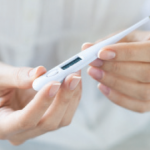I begin by examining Hayden Morse’s scalp. Lupus patients often have patches of alopecia—discrete areas of hair loss. Mrs. Morse’s scalp is luxuriously normal. There is no butterfly rash across the cheeks. The oral cavity does not demonstrate ulcerations. There is no pericardial rub—a sign of inflammation in the sac surrounding the heart—and the lungs are clear. Her joints are benign: there is no swelling, warmth or limited motion.
She is tender in the soft tissues of the neck and shoulders. She flinches when I palpate her forearms, low back and thighs. I ask Mrs. Morse to lift up her arms and tell her that I need to palpate the armpit for signs of lymph node enlargement. In some cases, silicone breast implants have been known to rupture, setting off an inflammatory reaction in the adjacent lymph nodes. Although the area is exquisitely tender there are no palpable lymph nodes and no tissue thickening. With the exception of scattered muscular tenderness, my examination is unremarkable.
Next, I test various muscle groups for weakness. With some encouragement, Mrs. Morse gives a good effort and convinces me there is no true weakness.
Behind me, her mother clears her throat. She wants me to know just how weak her daughter truly is. “Today, she looks pretty good. She doesn’t want you to see how weak she really is. She’s giving you her best effort, but I know tomorrow, she’ll be in bed all day.”
“Mother. I will not. That’s not true.”
Lupus is not a disease diagnosed by a checklist of symptoms & a borderline ANA. The diagnosis requires objective physical findings & significant, widespread lab abnormalities. … There’s treatment for lupus. With the proper medications, nearly all of my lupus patients are living well with their disease.
“It is so. Dr. Radis, I need to tell you something. Like I said, when Hayden has taken to bed, she calls me, and I come over and get the children fed, dressed and off to school. What I didn’t say, is that those are the mornings I have to feed her!”
“Well, she’s lucky to have you,” I say, half-listening, as I finished up with my neurologic exam. “It must be a great help to have you to pitch in with the cooking.”
“No, Dr. Radis,” she says sharply. My head spins round. “I’m saying I have to come over some mornings and feed her!” With that, the mother dips an imaginary spoon into a bowl, pushes it toward Mrs. Morse’s mouth, squeezes her cheeks and gives her daughter a spoonful of pretend cereal. Then, she takes out her handkerchief and dabs her daughter’s mouth. My reflex hammer falls to the floor. I sit down and record my findings, hoping to avoid any eye contact. Normal. Normal. Normal.
